100 Years of Land-Use and Land-Cover Data: What Has Been the Effect of Spatial Planning in Coastal Land-Use and Land-Cover Change?
Abstract
1. Introduction
2. Materials and Methods
2.1. Study Area
2.2. Research Data Sources
2.2.1. Land-Use and Land-Cover Data
2.2.2. Land-Use Planning Data
2.2.3. Spatial Determinants
2.3. Spatial Analysis Techniques
2.4. Land-Use and Land-Cover Change Simulation
3. Results
3.1. Analysis of the Effects of Land-Use Planning Policies on LULC Change
3.1.1. LULC Change under the Control of Guiding Plans: 1958–1995
3.1.2. LULC Change under the Control of Mandatory Plans: 1995–2018
3.2. Analysis of the Expected LULC Change under the Control of Mandatory Plans
4. Discussion
5. Conclusions
Author Contributions
Funding
Institutional Review Board Statement
Informed Consent Statement
Data Availability Statement
Acknowledgments
Conflicts of Interest
References
- Tenedório, J.A. Télédétection, Systèmes d’information Géographique et Suivi de l’étalement Périurbain Dans l’aire Métropolitaine de Lisbonne (Remote Sensing and Geographical Information Systems: Monitoring the Urban Fringe Expansion of the Lisbon Metropolitan Area). Bull. L’association Géogr. Fr. 2001, 78, 66–77. [Google Scholar] [CrossRef]
- Faria de Deus, R.; Tenedório, J.A. Coastal Land-Use and Land-Cover Change Trajectories: Are They Sustainable? Sustainability 2021, 13, 8840. [Google Scholar] [CrossRef]
- Lambin, E.F.; Geist, H.J. Land-Use and Land-Cover Change: Local Processes and Global Impacts; Springer: Berlin/Heidelberg, Germany, 2006. [Google Scholar]
- Rojas, C.; Pino, J. Assessing Land-Use and -Cover Changes in Relation to Geographic Factors and Urban Planning in the Metropolitan Area of Concepción (Chile). Implications for Biodiversity Conservation. Appl. Geogr. 2013, 39, 93–103. [Google Scholar] [CrossRef]
- Rogan, J.; Chen, D. Remote Sensing Technology for Mapping and Monitoring Land-Cover and Land-Use Change. Prog. Plan. 2004, 61, 301–325. [Google Scholar] [CrossRef]
- Moulds, S.; Buytaert, W.; Mijic, A. A Spatio-Temporal Land Use and Land Cover Reconstruction for India from 1960–2010. Sci. Data 2018, 5, 180159. [Google Scholar] [CrossRef]
- Mäyrä, J.; Kivinen, S.; Keski-Saari, S.; Poikolainen, L.; Kumpula, T. Utilizing Historical Maps in Identification of Long-Term Land Use and Land Cover Changes. Ambio 2023. [Google Scholar] [CrossRef]
- Sourn, T.; Pok, S.; Chou, P.; Nut, N.; Theng, D.; Rath, P.; Reyes, M.R.; Prasad, P.V.V. Evaluation of Land Use and Land Cover Change and Its Drivers in Battambang Province, Cambodia from 1998 to 2018. Sustainability 2021, 13, 11170. [Google Scholar] [CrossRef]
- Fathizad, H.; Tazeh, M.; Kalantari, S.; Shojaei, S. The Investigation of Spatiotemporal Variations of Land Surface Temperature Based on Land Use Changes Using NDVI in Southwest of Iran. J. Afr. Earth Sci. 2017, 134, 249–256. [Google Scholar] [CrossRef]
- Leta, M.K.; Demissie, T.A.; Tränckner, J. Modeling and Prediction of Land Use Land Cover Change Dynamics Based on Land Change Modeler (LCM) in Nashe Watershed, Upper Blue Nile Basin, Ethiopia. Sustainability 2021, 13, 3740. [Google Scholar] [CrossRef]
- Radwan, T.M.; Blackburn, G.A.; Whyatt, J.D.; Atkinson, P.M. Global Land Cover Trajectories and Transitions. Sci. Rep. 2021, 11, 12814. [Google Scholar] [CrossRef]
- Mingarro, M.; Lobo, J.M. European National Parks Protect Their Surroundings but Not Everywhere: A Study Using Land Use/Land Cover Dynamics Derived from CORINE Land Cover Data. Land Use Policy 2023, 124, 106434. [Google Scholar] [CrossRef]
- Matlhodi, B.; Kenabatho, P.K.; Parida, B.P.; Maphanyane, J.G. Analysis of the Future Land Use Land Cover Changes in the Gaborone Dam Catchment Using CA-Markov Model: Implications on Water Resources. Remote Sens. 2021, 13, 2427. [Google Scholar] [CrossRef]
- Hersperger, A.M.; Oliveira, E.; Pagliarin, S.; Palka, G.; Verburg, P.; Bolliger, J.; Grădinaru, S. Urban Land-Use Change: The Role of Strategic Spatial Planning. Glob. Environ. Chang. 2018, 51, 32–42. [Google Scholar] [CrossRef]
- UN DESA. The Sustainable Development Goals Report 2022; Statistics, Sustainable Development; UN DESA: New York, NY, USA, 2022. [Google Scholar]
- Stead, D.; Nadin, V. Spatial Planning. Key Instrument for Development and Effective Governance with Special Reference to Countries in Transition; United Nations Economic Commission for Europe; United Nations: Geneva, Switzerland, 2008.
- Koomen, E.; Rietveld, P.; de Nijs, T. Modelling Land-Use Change for Spatial Planning Support. Ann. Reg. Sci. 2008, 42, 1–10. [Google Scholar] [CrossRef]
- Amato, F.; Maimone, B.A.; Martellozzo, F.; Nolè, G.; Murgante, B. The Effects of Urban Policies on the Development of Urban Areas. Sustainability 2016, 8, 297. [Google Scholar] [CrossRef]
- Domingo, D.; Palka, G.; Hersperger, A.M. Effect of Zoning Plans on Urban Land-Use Change: A Multi-Scenario Simulation for Supporting Sustainable Urban Growth. Sustain. Cities Soc. 2021, 69, 102833. [Google Scholar] [CrossRef]
- Carter, J.G. Urban Climate Change Adaptation: Exploring the Implications of Future Land Cover Scenarios. Cities 2018, 77, 73–80. [Google Scholar] [CrossRef]
- Domingo, D.; van Vliet, J.; Hersperger, A.M. Long-Term Changes in 3D Urban Form in Four Spanish Cities. Landsc. Urban Plan. 2023, 230, 104624. [Google Scholar] [CrossRef]
- Koomen, E.; Dekkers, J. The Impact of Land-Use Policy on Urban Fringe Dynamics. In Cities and Nature; Springer: Berlin/Heidelberg, Germany, 2013; pp. 9–35. ISBN 978-3-642-40199-2. [Google Scholar]
- Erickson, D.L. Rural Land Use and Land Cover Change: Implications for Local Planning in the River Raisin Watershed. Land Use Policy 1995, 12, 223–236. [Google Scholar] [CrossRef]
- Wang, C.; Wang, Y.; Wang, R.; Zheng, P. Modeling and Evaluating Land-Use/Land-Cover Change for Urban Planning and Sustainability: A Case Study of Dongying City, China. J. Clean. Prod. 2018, 172, 1529–1534. [Google Scholar] [CrossRef]
- Abrantes, P.; Fontes, I.; Gomes, E.; Rocha, J. Compliance of Land Cover Changes with Municipal Land Use Planning: Evidence from the Lisbon Metropolitan Region (1990–2007). Land Use Policy 2016, 51, 120–134. [Google Scholar] [CrossRef]
- Daunt, A.B.P.; Inostroza, L.; Hersperger, A.M. The Role of Spatial Planning in Land Change: An Assessment of Urban Planning and Nature Conservation Efficiency at the Southeastern Coast of Brazil. Land Use Policy 2021, 111, 105771. [Google Scholar] [CrossRef]
- Faria de Deus, R. GIS-Based Measurement, Analysis and Modelling of Land-Use and Land-Cover Change in Coastal Areas. The Case of the Algarve-Portugal. Ph.D. Thesis, Universidade Nova de Lisboa, Lisbon, Portugal, 2015. [Google Scholar]
- Santos, T.; Deus, R.; Rocha, J.; Tenedório, J.A. Assessing Sustainable Urban Development Trends in a Dynamic Tourist Coastal Area Using 3D Spatial Indicators. Energies 2021, 14, 5044. [Google Scholar] [CrossRef]
- Statistics Portugal. Statistics Portugal Population and Housing Census 2021; Statistics Portugal: Lisbon, Portugal, 2021.
- Statistics Portugal. Statistic Portugal Projections of Resident Population in Portugal 2018–2080; Statistics Portugal: Lisbon, Portugal, 2020.
- Statistics Portugal. Statistics Portugal Population and Housing Census 2011; Statistics Portugal: Lisbon, Portugal, 2011.
- Statistics Portugal. Statistics Portugal Population and Housing Census 2001; Statistics Portugal: Lisbon, Portugal, 2001.
- Statistics Portugal. Statistics Portugal Population and Housing Census 1991; Statistics Portugal: Lisbon, Portugal, 1991.
- Faria de Deus, R.; Tenedório, J.A.; Moix Bergadà, M. Urban Sprawl in Portugal Based on Urban Systems Spatial Boundaries. ACE 2012, 7, 131–148. [Google Scholar] [CrossRef]
- SNIG. National Geographic Information Infrastructure Portugal 2022; SNIG, Direção-Geral do Território: Lisbon, Portugal, 2022. [Google Scholar]
- de Deus, R.F.; Tenedório, J.A.; Rocha, J. Modelling Land-Use and Land-Cover Changes: A Hybrid Approach to a Coastal Area. In Methods and Applications of Geospatial Technology in Sustainable Urbanism; Tenedório, J.A., Estanqueiro, R., Henriques, C.D., Eds.; IGI Global: Hershey, PA, USA, 2021; pp. 57–102. ISBN 978-1-79982-249-3. [Google Scholar]
- Eastman, J.R.; Jiang, H.; Toledano, J. Multi-Criteria and Multi-Objective Decision Making for Land Allocation Using GIS. In Multicriteria Analysis for Land-Use Management; Beinat, E., Nijkamp, P., Eds.; Springer: Dordrecht, The Netherlands, 1998; pp. 227–251. ISBN 978-94-015-9058-7. [Google Scholar]
- Cohen, J. A Coefficient of Agreement for Nominal Scales. Educ. Psychol. Meas. 1960, 20, 37–46. [Google Scholar] [CrossRef]
- van den Berg, L.; Drewett, R.; Lh, K.; Rossi, A.; Cht, V. Urban Europe: A Study of Growth and Decline; Pergamon: Oxford, UK, 1982. [Google Scholar]
- Alfasi, N.; Benenson, I.; Almagor, J. The Actual Impact of Comprehensive Land-Use Plans: Insights from High Resolution Observations. Land Use Policy 2012, 29, 862–877. [Google Scholar] [CrossRef]
- Ferreira, J.A.; Condessa, B.; Castro e Almeida, J.; Pinto, P. Urban Settlements Delimitation in Low-Density Areas—An Application to the Municipality of Tomar (Portugal). Landsc. Urban Plan. 2010, 97, 156–167. [Google Scholar] [CrossRef]
- Abrantes, P.; Marques da Costa, E.; Queirós, M.; Padeiro, M.; Mousselin, G. Lezíria Do Tejo: Agriculture et Étalement Urbain Aux Marges Métropolitaines de Lisbonne. Cah. Agric. 2013, 22, 526–534. [Google Scholar] [CrossRef]
- Wu, Y.; Fan, P.; Li, B.; Ouyang, Z.; Liu, Y.; You, H. The Effectiveness of Planning Control on Urban Growth: Evidence from Hangzhou, China. Sustainability 2017, 9, 855. [Google Scholar] [CrossRef]
- Hewitt, R.; Escobar, F. The Territorial Dynamics of Fast-Growing Regions: Unsustainable Land Use Change and Future Policy Challenges in Madrid, Spain. Appl. Geogr. 2011, 31, 650–667. [Google Scholar] [CrossRef]
- Dutta, V. Land Use Dynamics and Peri-Urban Growth Characteristics Reflections on Master Plan and Urban Suitability from a Sprawling North Indian City. Environ. Urban. Asia 2012, 3, 277–301. [Google Scholar] [CrossRef]
- Concepción, E.D. Urban Sprawl into Natura 2000 Network over Europe. Conserv. Biol. 2021, 35, 1063–1072. [Google Scholar] [CrossRef]
- Silva, E.A.; Clarke, K.C. Complexity, Emergence and Cellular Urban Models: Lessons Learned from Applying SLEUTH to Two Portuguese Metropolitan Areas. Eur. Plan. Stud. 2005, 13, 93–115. [Google Scholar] [CrossRef]
- Padeiro, M. The Influence of Transport Infrastructures on Land-Use Conversion Decisions within Municipal Plans. JTLU 2014, 7, 79–93. [Google Scholar] [CrossRef]
- Zitti, M.; Ferrara, C.; Perini, L.; Carlucci, M.; Salvati, L. Long-Term Urban Growth and Land Use Efficiency in Southern Europe: Implications for Sustainable Land Management. Sustainability 2015, 7, 3359–3385. [Google Scholar] [CrossRef]
- Zambon, I.; Serra, P.; Pili, S.; Bernardini, V.; Ferrara, C.; Salvati, L. A New Approach to Land-Use Structure: Patch Perimeter Metrics as a Spatial Analysis Tool. Sustainability 2018, 10, 2147. [Google Scholar] [CrossRef]
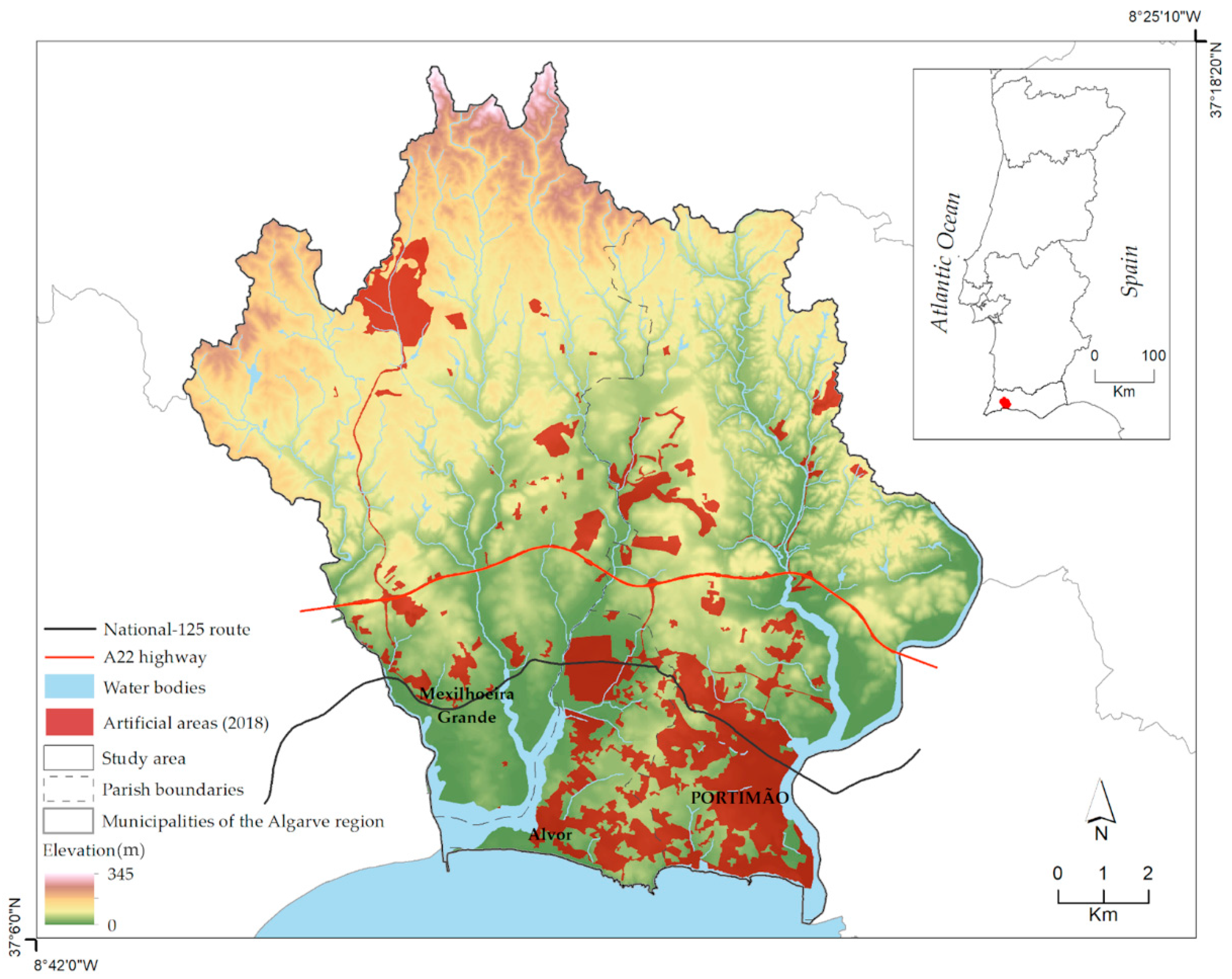

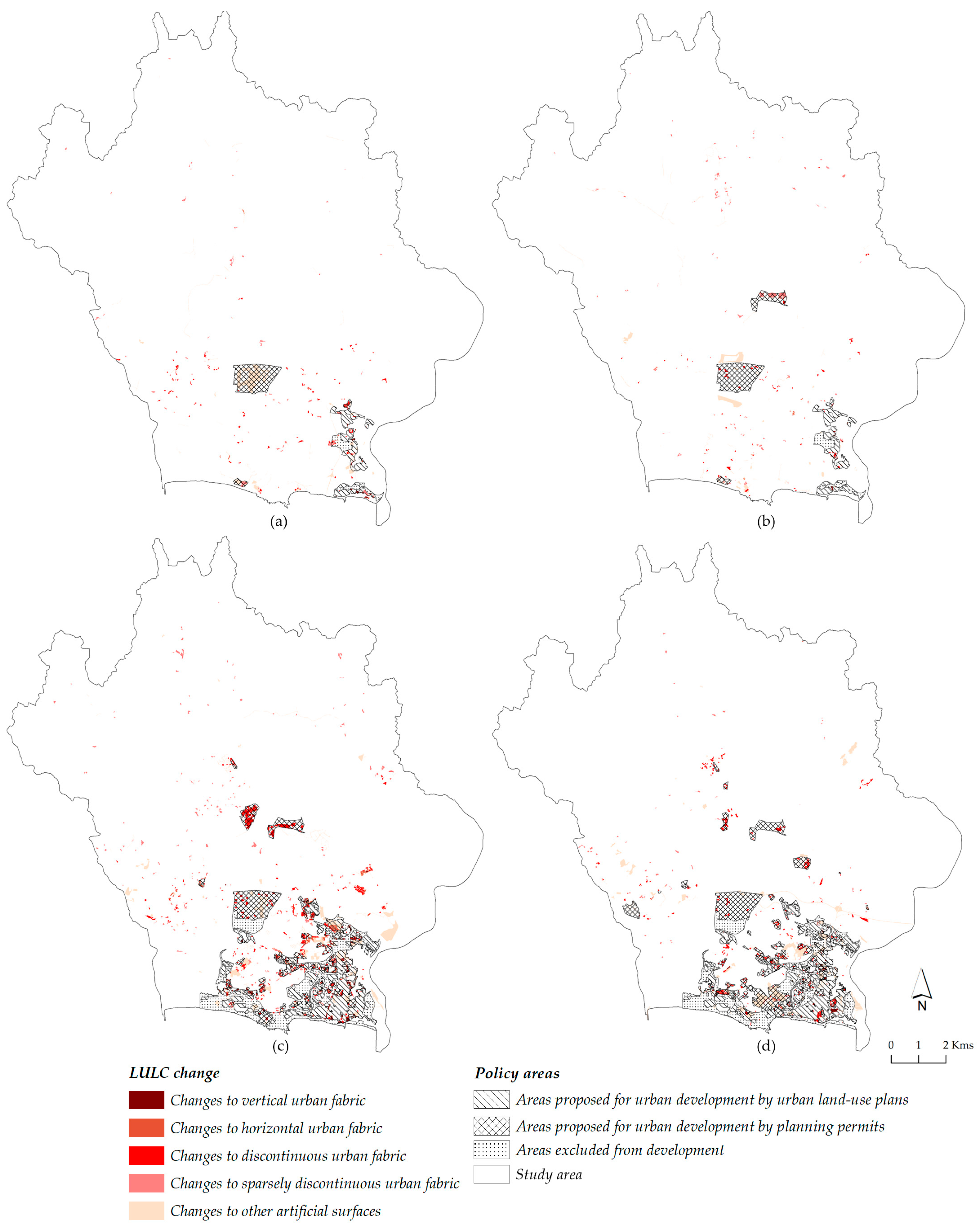
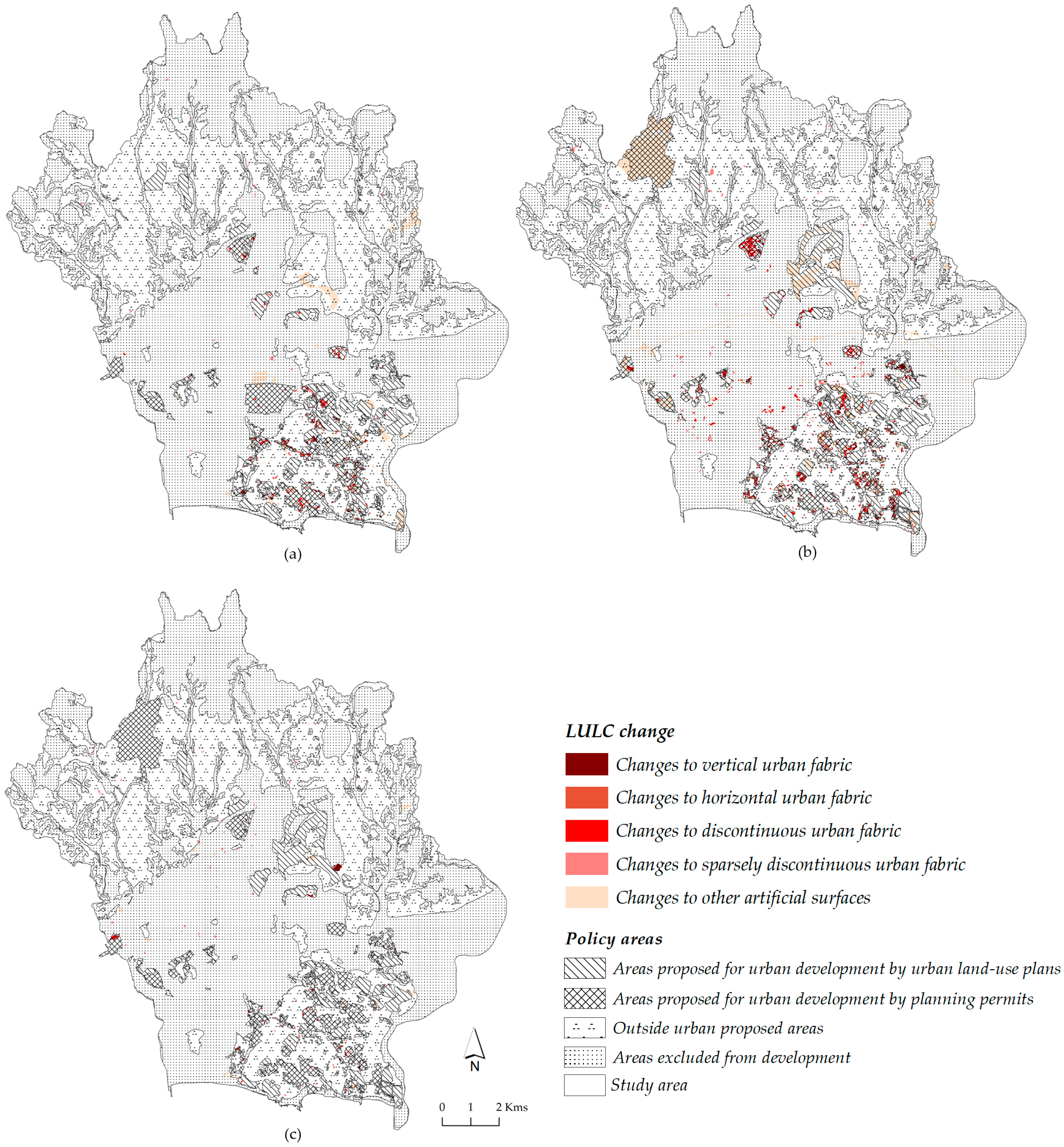
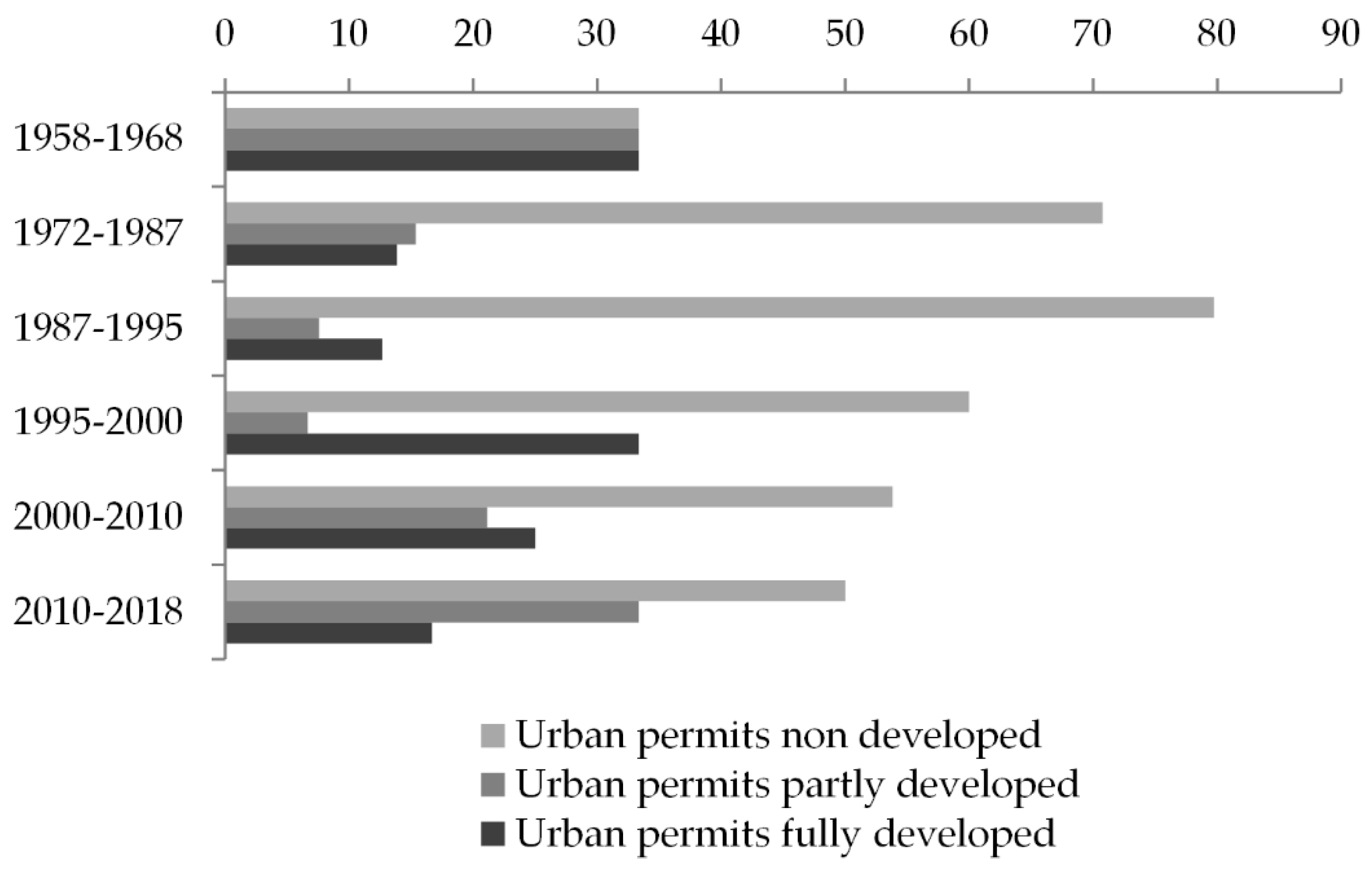

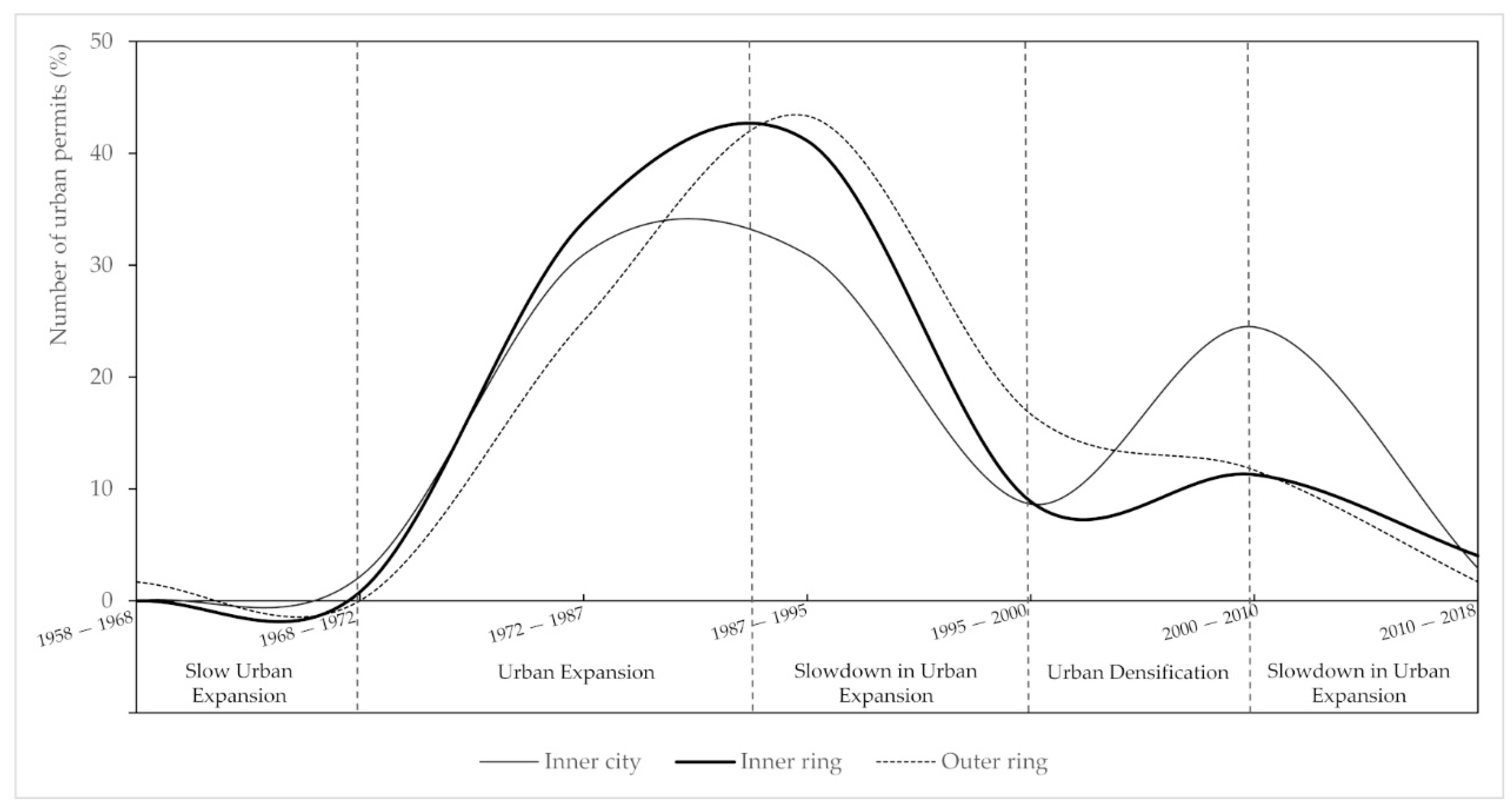
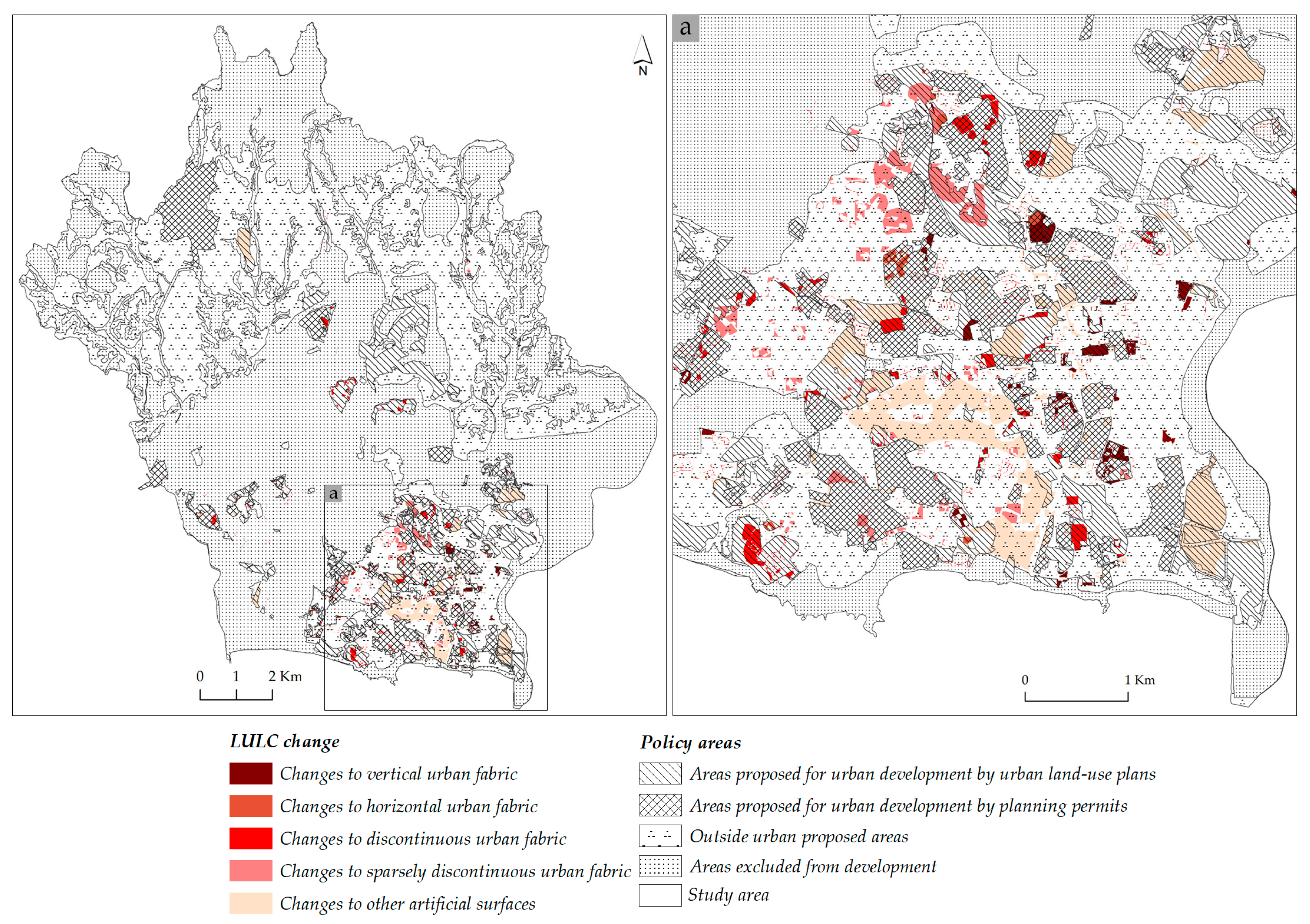
| Period | TUV | TUH | TUD | TUDE | OAA | Total LULC Change | |
|---|---|---|---|---|---|---|---|
| 1958–1968 | Within urban land-use plans 1 | 63.3 | 29.0 | 17.2 | 7.2 | 6.7 | 10.5 |
| Within planning permits 2 | 4.6 | 3.4 | 8.6 | 12.7 | 59.8 | 41.8 | |
| Outside urban proposed | 32.2 | 63.2 | 71.4 | 74.7 | 30.8 | 44.6 | |
| Areas excluded from development | 0.0 | 4.5 | 2.8 | 5.5 | 2.7 | 3.1 | |
| 1968–1972 | Within urban land-use plans | 64.6 | 21.0 | 10.5 | 0.0 | 2.1 | 4.3 |
| Within planning permits | 0.0 | 0.0 | 30.5 | 35.0 | 8.8 | 18.6 | |
| Outside urban proposed | 25.9 | 79.0 | 59.0 | 65.0 | 88.5 | 76.6 | |
| Areas excluded from development | 9.5 | 0.0 | 0.0 | 0.0 | 0.6 | 0.5 | |
| 1972–1987 | Within urban land-use plans | 66.6 | 23.1 | 7.5 | 3.4 | 20.9 | 16.9 |
| Within planning permits | 10.8 | 18.3 | 53.0 | 9.5 | 17.9 | 27.4 | |
| Outside urban proposed | 9.6 | 50.2 | 33.3 | 84.7 | 52.8 | 48.5 | |
| Areas excluded from development | 12.9 | 8.4 | 6.2 | 2.4 | 8.4 | 7.2 | |
| 1987–1995 | Within urban land-use plans | 44.7 | 9.1 | 7.2 | 0.3 | 15.8 | 14.0 |
| Within planning permits | 39.5 | 47.4 | 57.1 | 19.9 | 30.2 | 37.6 | |
| Outside urban proposed | 4.7 | 37.7 | 33.1 | 75.8 | 46.4 | 42.2 | |
| Areas excluded from development | 11.1 | 5.8 | 2.6 | 4.0 | 7.6 | 6.2 | |
| 1995–2000 | Within urban land-use plans + MMP | 21.4 | 28.0 | 15.6 | 7.7 | 16.2 | 15.9 |
| Within planning permits | 53.3 | 57.6 | 74.0 | 30.4 | 16.3 | 29.0 | |
| Outside urban proposed | 25.3 | 7.8 | 7.2 | 36.1 | 42.8 | 35.2 | |
| Areas excluded from development | 0.0 | 6.6 | 3.2 | 25.8 | 24.8 | 19.9 | |
| 2000–2010 | Within urban land-use plans + MMP | 8.3 | 15.3 | 15.4 | 0.8 | 20.8 | 17.2 |
| Within planning permits | 75.3 | 49.1 | 54.4 | 70.6 | 54.2 | 56.7 | |
| Outside urban proposed | 16.0 | 24.9 | 13.0 | 14.8 | 12.0 | 12.8 | |
| Areas excluded from development | 0.5 | 10.7 | 17.3 | 13.8 | 13.0 | 13.3 | |
| 2010–2018 | Within urban land-use plans + MMP | 1.3 | 4.2 | 16.5 | 1.8 | 19.2 | 14.6 |
| Within planning permits | 22.8 | 62.5 | 49.6 | 6.5 | 12.8 | 18.0 | |
| Outside urban proposed | 68.4 | 29.2 | 22.6 | 47.3 | 32.4 | 36.0 | |
| Areas excluded from development | 7.6 | 4.2 | 11.3 | 44.4 | 35.6 | 31.4 | |
| 2018–2047 3 | Within urban land-use plans + MMP | 46.4 | 43.4 | 73.0 | 34.4 | 52.4 | 51.6 |
| Within planning permits | 41.6 | 52.6 | 24.6 | 6.5 | 6.3 | 11.4 | |
| Outside urban proposed | 11.6 | 2.6 | 1.7 | 58.2 | 37.3 | 34.2 | |
| Areas excluded from development | 0.4 | 1.3 | 0.7 | 0.8 | 4.0 | 2.9 |
Disclaimer/Publisher’s Note: The statements, opinions and data contained in all publications are solely those of the individual author(s) and contributor(s) and not of MDPI and/or the editor(s). MDPI and/or the editor(s) disclaim responsibility for any injury to people or property resulting from any ideas, methods, instructions or products referred to in the content. |
© 2023 by the authors. Licensee MDPI, Basel, Switzerland. This article is an open access article distributed under the terms and conditions of the Creative Commons Attribution (CC BY) license (https://creativecommons.org/licenses/by/4.0/).
Share and Cite
Faria de Deus, R.; Tenedório, J.A.; Pumain, D.; Rocha, J.; Pereira, M. 100 Years of Land-Use and Land-Cover Data: What Has Been the Effect of Spatial Planning in Coastal Land-Use and Land-Cover Change? Sustainability 2023, 15, 7636. https://doi.org/10.3390/su15097636
Faria de Deus R, Tenedório JA, Pumain D, Rocha J, Pereira M. 100 Years of Land-Use and Land-Cover Data: What Has Been the Effect of Spatial Planning in Coastal Land-Use and Land-Cover Change? Sustainability. 2023; 15(9):7636. https://doi.org/10.3390/su15097636
Chicago/Turabian StyleFaria de Deus, Raquel, José António Tenedório, Denise Pumain, Jorge Rocha, and Margarida Pereira. 2023. "100 Years of Land-Use and Land-Cover Data: What Has Been the Effect of Spatial Planning in Coastal Land-Use and Land-Cover Change?" Sustainability 15, no. 9: 7636. https://doi.org/10.3390/su15097636
APA StyleFaria de Deus, R., Tenedório, J. A., Pumain, D., Rocha, J., & Pereira, M. (2023). 100 Years of Land-Use and Land-Cover Data: What Has Been the Effect of Spatial Planning in Coastal Land-Use and Land-Cover Change? Sustainability, 15(9), 7636. https://doi.org/10.3390/su15097636









